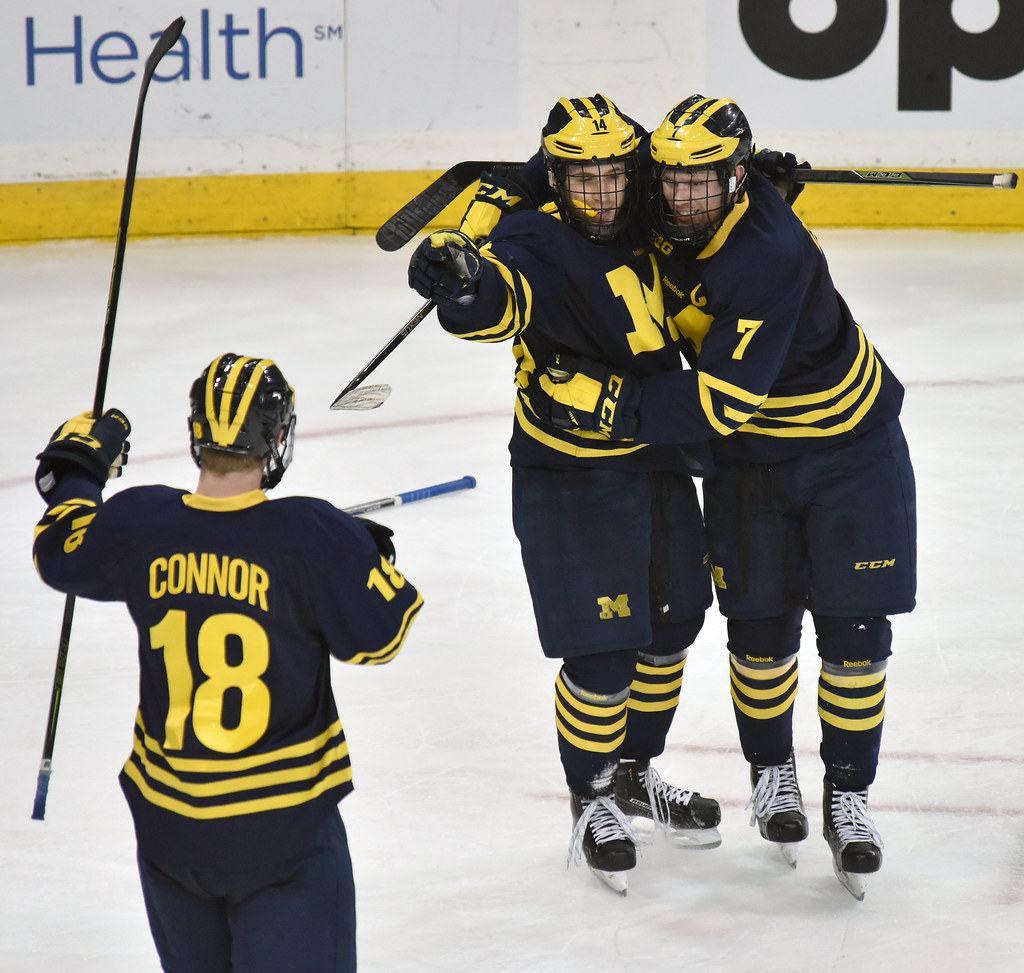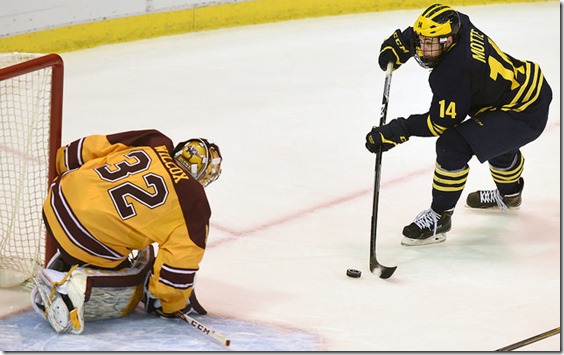tyler motte

A note on content. You may have noticed I'm not posting every day as I have for eons. This is suddenly season preview cram time for me, to go along with no daycare for two small kids and an online semester for my wife that is extremely time consuming. Bear with us, please.
Tyler Motte on his mental health. A member of the CCM line opens up about his struggles:
Motte, now 25, paused for a moment. "Actually," he said. "There is one thing." Then the words started flowing out of his mouth before he could consider the significance.
"Earlier in the summer, I was diagnosed with anxiety and depression," Motte said. "Do we have somebody for that?"
Long and worth yoru time.
The thing Clowney lacks. Jadeveon Clowney is now a highly regarded NFL defensive end with a weird inability to convert pressures into sacks. For The Win looks into why:
Finishing off a pass rush is a skill and the numbers suggest that Clowney does not possess it. But in order to confirm that theory — and figure out why he struggles to turn pressure into sacks — I took a look at all of his pressures from the 2019 season. From there, I picked out the plays where Clowney had a significant effect on the quarterback. Here’s a cut-up of those plays…
It shouldn’t take too long to pick up on the pattern: On nearly every win, Clowney uses an inside move to beat his blocker. …
When you really dive into his tape, which NFL teams surely did this offseason, Clowney’s biggest weakness becomes readily apparent: He’s got no bend. In other words, after beating an offensive tackle upfield, he struggles to turn the corner, which makes it much easier for the tackle to recover and block him.
This was also a problem for Rashan Gary, another giant athletic freak of a defensive end, at Michigan. Gary's attempts to win to the outside were ineffective because he couldn't dip around the offensive tackle. In contrast, Josh Uche is all bend.
This doesn't mean Clowney isn't a good defensive end. He grades out well everywhere that offers grades. It does mean his production is usually limited to hurries and various pocket disruptions.
[After THE JUMP: a plea for 80 yard Ben Mason touchdowns]

[Sherman/MGoBlog]
Yesterday I was thumbing through a notebook I use for interview prep and found a projected line chart I wrote last summer for the 2015-16 hockey season. It had Tyler Motte, JT Compher, and Alex Kile on the first line; I had Kyle Connor on the second. I chortled under my breath and moved on. It was only in doing research for this piece that I rediscovered how long- two months(!)- the lines were arranged as such. It's easy to forget that Michigan started their season without Connor, Compher, and Motte together, with the trio we'll affectionately remember as the CCM line not seeing game action until the beginning of December.
Connor, Compher, and Motte launched a four-month-long assault on the Big Ten and the Michigan record books that produced numbers that will be tough to come across in the near future. They also produced the kind of moments that become seared into your sports consciousness; sports memories tend to be grounded in moments, not the chronology of events. I still remember walking up State Street after some game during the 2007-08 season and marveling at Kolarik and Porter the whole way back. I don't remember which game, but I remember exactly what it felt like to be a witness to something special. I liked Michigan hockey before 2007-08, but the credit for why I care enough to want to break down every goal scored over the course of every season falls squarely on Kevin Porter and Chad Kolarik's shoulders.
That feeling was back this year. For the first time in at least eight season we weren't just watching great players play, we were watching players play perfectly off of each other and accomplish things that caused that voice in the back of your mind to pick up decibels until it's practically screaming at you, reminding you that this is something to hold on to, something that doesn't happen every season.
The numbers give context to the memories: Connor led the nation in scoring and goals, Compher finished second in scoring nationally and led the country in assists, and Motte finished fourth in scoring nationally. Motte scored a goal in 12 straight games, a Berenson-era record; Connor ended the season with a 27-game point streak, another Berenson-era record. Connor scored more goals than any other freshman in Michigan history while finishing second in all-time freshman points. Compher had the second most assists of any junior in Michigan history. Compher, Connor, and Motte were three of the top 10 finalists for the Hobey Baker, which is just the third time in the award's history that one school has placed three players in the top 10. (Michigan also did it in 1994, when Steve Shields, Brian Wiseman, and David Oliver were finalists.)
Michigan's roster next year will look different, and it's not just because it's missing two guys (and possibly a third) who scored in droves. The way they played together is what set the CCM line apart. It's something that you don't see in hockey very often these days; creativity and communication can create beautiful plays, but the system a player is a part of has to allow the player to take some liberties for that to transpire. Michigan's system is well suited for that, and the results speak volumes not just about the system but about the way the abilities of three players blended to create a scoring threat that was nearly unstoppable.
Igor Larionov wrote a piece for The Players' Tribune that I've seen passed around NHL circles again recently, and the crux of his argument is that players are told to over-simplify their game at too early an age in order to eliminate risk. In his mind, this stifles creativity and leaves only a handful of players in the NHL who think the game three or four moves ahead and then act on those suppositions. In his words:
Our philosophy was about puck control, improvisation, and constant movement. Now, the game is all about “north-south,” chip-and-chase. We moved side-to-side and swooped around the ice looking for open spaces. A backward pass was just as good as a forward pass. You didn’t have to see your linemate. You could smell him. Honestly, we probably could have played blind.
Michigan had three boundlessly creative players on the same line. Connor's accuracy and quick release made him the perfect finisher, always open thanks to his linemates' ability to maintain possession and positioning near the net. Compher had some of the finest olfaction of any Michigan skater I've seen, seemingly throwing the puck around blindly only to put it precisely on the tape of his teammate's stick. Motte could turn and lift a puck from a sharp angle in such a way that the puck seemed to explode off his blade; he was the perfect netfront presence.
With a few exceptions, these three showed that you can be responsible defensively while also being creative offensively, and in the process they crafted moments that transcended box scores. To borrow from Red Berenson by way of Dickie Moore, you can't buy that kind of fun.
[After THE JUMP: I empty out my "CCM line" gif folder]
[Paul Sherman]
The band, it is no longer together:
Breaking: Red Berenson has told me Tyler Motte will forgo his senior season and sign with the Chicago Blackhawks
— Jason Rubinstein (@jrubinstein4) April 6, 2016
That's particularly bad since Motte was widely regarded as the least likely CCM line member to leave. Berenson did tell The Michigan Insider that he was "betting" on a Compher return, but Compher and Motte have been joined at the hip for years now—this news could impact his status.
Motte's lightning release and mind-meld with Compher led to a point explosion as a junior. Last year he recorded a 32-24-56 line in 38 games. He banged home the OT winner against Notre Dame in the tournament. He'll be acutely missed on next year's team.

41